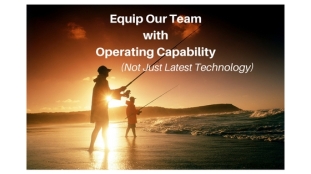
Give a man a fish and you feed him for a day. Teach a man how to fish and you feed him for a lifetime – Chinese Proverb
Similar to the proverb above, we all know that give a man a fast boat or an expensive fishing rod wouldn’t help if teaching him to fish is not part of the package. Yet this conventional wisdom is oftentimes being ignored in technology implementations. As a result of that, many good projects were subsequently abandoned because lacked of funding allocation for continuous maintenance and training.
Sounds familiar? While future proofing our technology equipment is important but we wouldn’t able to benefit much without continuous human resource development. Although many current practices put Transfer of Technology (ToT) in initial project implementation but this one-off initiative oftentimes become the hairline crack that eventually sink the mightiest ship. The results: we often realized too late, spearheading human operating capability is still very much an on-going battle, long after acquiring the greatest technologies.
Among the reasons that warrant this on-going efforts by setting aside annual training budget are:-
- People movement due to job transfer, retirement or new team members on-board
- New technology versions/releases might cause previous workflow to be obsolete or irrelevant
- New innovations/inventions that can be embedded to enhance efficiency and save time/cost
- Take full advantage of latest configuration/integration capabilities
Formula to ensure continuous success of GIS implementation is to ensure both technology and operating capability is updated/maintained persistently. Equipping our team with the right operating capabilities deserved constant attention of all senior executives that want to make a difference.
When I was leading Esri Malaysia team, continuously equipping my team with relevant capabilities and guide them to excel in whatever they do is one of the most rewarding effort that propelled the company into spectacles growth trajectory. A trained and competent team is always more motivated, confident and committed to undertake new challenges. I suggest all senior executives shall put utmost emphasis on up-keeping operating capability for their team in order to fully leverage and maximize their ROI on technology investments.
This writer hopes to see more organizations will allocate annual training budget to equip their team with relevant operating capabilities. How about an acid test for all: “How much have we set aside our budget for operating capability training this year?”


 I was from GIS old school that spent most of my previous GIS career on desktop-based GIS environment. While I’m pretty comfortable with desktop-based GIS, I have to acknowledge the new emerging trend in web, cloud/device GIS deployment pattern. Web and cloud GIS offer both a fascinating and whole new world to me. In order to play catch up and bring myself up to speed with the latest technology trend, I do spend a lot of time reading and asking – especially by leveraging on many smart people around me.
I was from GIS old school that spent most of my previous GIS career on desktop-based GIS environment. While I’m pretty comfortable with desktop-based GIS, I have to acknowledge the new emerging trend in web, cloud/device GIS deployment pattern. Web and cloud GIS offer both a fascinating and whole new world to me. In order to play catch up and bring myself up to speed with the latest technology trend, I do spend a lot of time reading and asking – especially by leveraging on many smart people around me.